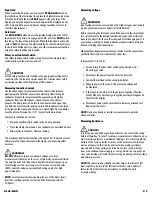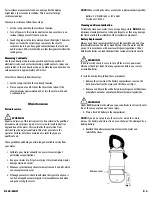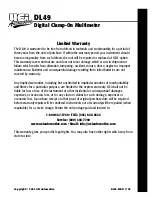
Peak Hold
When measuring AC amps you can use the
PEAK HOLD
button on
the right side of the instrument to capture the highest measured value.
Press and hold until the word
PEAK
appears along the top of the
display and only the highest measured value will be displayed on the
LCD. Press and hold a second time or change functions to return to
real-time measurement.
Data Hold
The
DATA HOLD
button freezes the reading displayed on the LCD at
the moment it is passed. To engage data hold, press the
HOLD
button,
located on the face of the instrument. When this function is active, the
symbol “
D.H
” appears on the digital display. To cancel data hold, press
the data hold button again, or select any other measurement function
using the rotary function select switch.
Rotary Function Select Switch
The rotary function select switch is used to select the measurement
mode and to turn the meter on and off.
CAUTION!
Set the rotary function select switch to the appropriate setting before
connecting the test leads to circuits under test. Observe those safety
precautions outline in the beginning of this manual.
Measuring Inductive Current
The inductive current measurement mode relies on the induced
electromagnetic field that occurs when electricity flows through a
conductor. Prepare for measurement be separating a single live
conductor from any other phase, neutral or ground conductor.
Squeeze the clamp lever, and place the conductor in the open jaws.
To attain the most accurate reading, ensure the conductor is centered
in the jaws of the clamp, and the jaws are closed tight. The conductor
must be able to fit inside the 1 1/4” (32 mm) fully closed jaws.
To measure inductive AC current:
1. Place the function select switch in the AC amp position.
2. Place the clamp jaw around a live conductor (as described above).
3. Allow meter to stabilize - Observe reading.
The maximum limit for this function is 400 amps AC. Too much current
will saturate the ferrous material in the clamp, and adversely affect
accuracy.
WARNING!
DO NOT
attempt to take any unknown voltage or current
measurements that may be in excess of this meter’s maximum limits.
To avoid the risk of electrical shock and instrument discharge, open
circuit voltage for the circuit under test must not exceed 600 volts
(RMS). Consider using an optional high voltage probe for high
power situations.
NOTE:
For all measurements requiring the use of the meter leads,
insert the red lead into the V/
Ω
port and the black lead into the
COM port.
Measuring Voltage
WARNING!
Input voltages must not exceed 600 volts. High voltages and currents
require greater awareness of physical safety hazards.
Before connecting the test leads; turn off the power to the circuit under
test; set the meter to the desired function and range; connect the test
leads to the meter first, then to the circuit under test. Reapply pow e r. If
an erroneous reading is observed, disconnect power immediately and
recheck all settings and connections.
When taking voltage measurements your meter must be connected in
p a rallel to the circuit, or circuit element, under test.
To measure DC or AC volts;
1. Set the rotary function select switch to the desired AC or
DC voltage position.
2. Disconnect the power from the circuit to be tested.
3. Connect the test leads to the circuit to be tested.
4. Reapply power to the circuit. The measured voltage will
be displayed.
5. If the input to the V/
Ω
port is lower (more negative) than the
black COM port, a minus sign (negative polarity) will appear on
the left of the display.
6. Disconnect power to the circuit before removing attached test
leads from the circuit.
NOTE:
During continuity or resistance measurements, polarity
does not matter.
Measuring Resistance
CAUTION!
Turn off power and discharge all capacitors on the circuit to be tested
before attempting “in circuit” resistance measurements. Failure to do so
may result in equipment or instrument damage. It is critical to both the
welfare of the meter, and the accuracy of the measurement, that you
remove all power to the circuit under test when making resistance
measurements. If any voltage is present in the test circuit, whether
from a conventional power supply, or energy stored in a capacitor, an
erroneous reading will result. This meter may be damaged if more than
600 volts are present.
NOTE:
When measuring critically low ohm values, touch tips of test
leads together and record the test lead resistance value. Subtract
this value from the total circuit resistance to obtain the most
accurate reading.
DL49-MAN
P. 3







